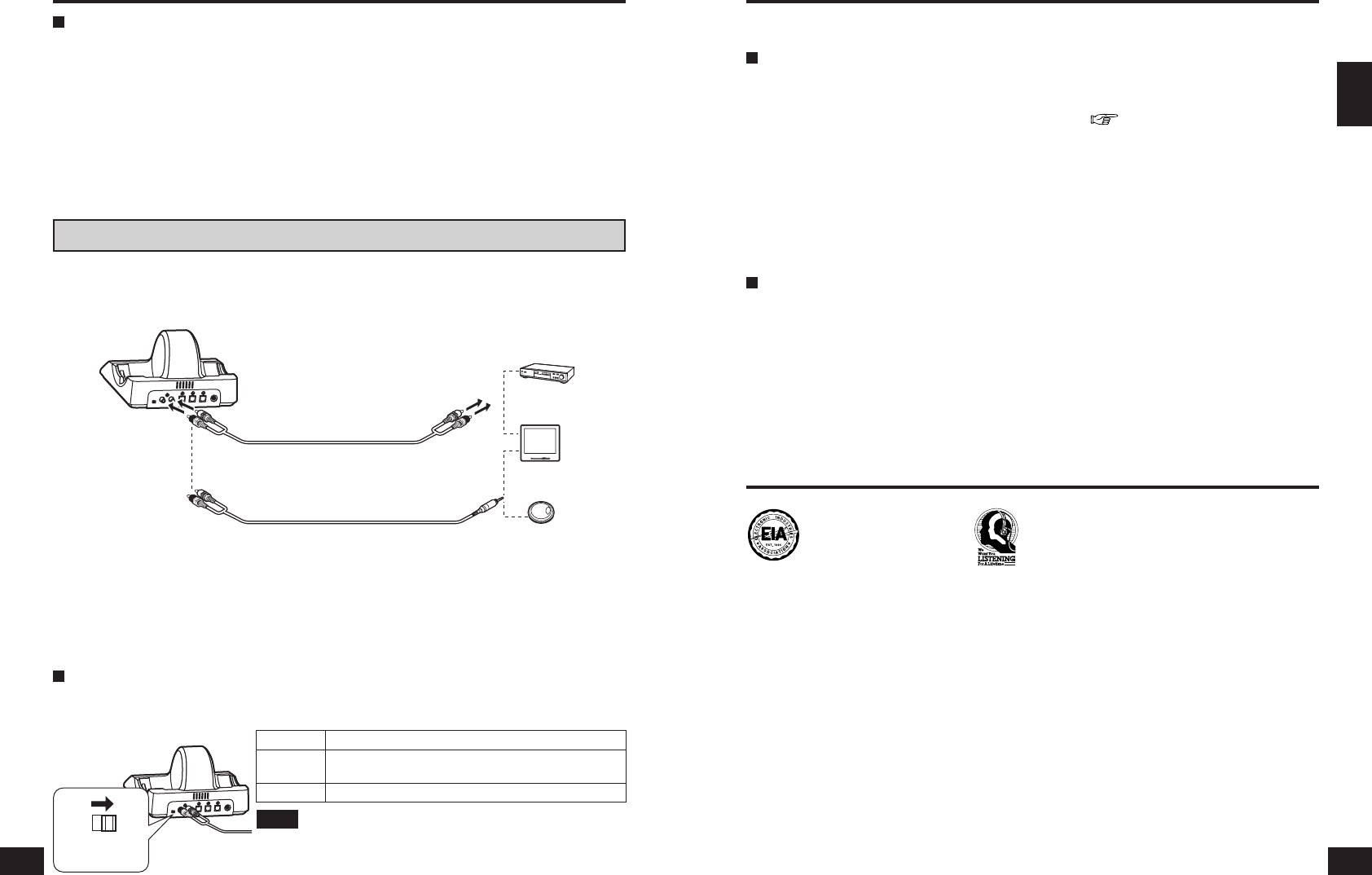
RQT8948
00
10
00
11
RQT8948
ENGLISH
Placement of transmitter and headphones
Playing DTS signals
Select the DTS audio signal on the connected equipment.
● A DTS compatible DVD player is necessary to play DVD discs recorded in DTS. (Refer to your DVD player’s
operating instructions for further details.)
● If “OFF” has been selected for the DVD player’s DTS digital setting, sound may not be output even when DTS
output is selected in the DVD menu.
● When connecting a DVD player and this unit with an analog connection, sound may not be output. Change to
a digital connection if this happens.
● There may be some noise emitted during functions such as rewinding and fast forwarding with a DTS format
DVD. This does not indicate a problem with the unit.
Audio cable (mini pin plug) (not included)
Use the audio cable (stereo mini plug to 2-pin plug) or similar to connect the transmitter’s LINE IN terminal to a
stereo mini headphone jack on the television or portable AV equipment. If the output level from the television
or portable AV equipment is set to low, there may be unwanted noise. Set the volume so the sound is not
distorted.
Connecting analog equipment
Use an audio cable when connecting the AUDIO OUT terminals of a video cassette player, television etc. to the
transmitter’s LINE IN (L/R) terminal.
ATT Control
When the sound is low with an analog connection, switch the ATT (attenuator) control on the Transmitter’s rear
panel to [0 dB].
The range of the radio waves
The radio waves have a maximum range of 30 m (98.4 ft.) from the transmitter.
The most appropriate frequency is automatically set when the headphones are taken off the transmitter. When
the headphones are used outside the range of the radio waves or the radio waves weaken, the sound is
broken. Move nearer to the transmitter or reset the frequency ( page 14 [Setting the most appropriate
frequency]).
● Since this unit is using the 2.4 GHz radio frequency band, obstacles (such as reinforced concrete walls
and metal doors) may cause the sound to be broken. This is a characteristic of radio waves and not a
malfunction.
● The sound heard from the headphones will differ depending on where the transmitter is placed and the kind
of location in which it is used. We recommend placing the transmitter where the sound is received best.
● The sound may be broken when the unit is used at the same time as other equipment that uses the 2.4 GHz
radio frequency band such as wireless equipment or microwaves.
Locations
Avoid placing the unit in the following locations
- Places with high temperatures such as near heating appliances or places directly exposed to sunlight
- Places with a lot of dust
- On top of unstable carts or inclined surfaces
- Places with excessive vibration
- Bathrooms and other moisture-prone places
ATT
0dB
–8dB
This unit uses radio waves to transmit the signals so it is recommended to use the headphones within the range
of the radio waves.
Note
● Reduce the volume before switching the ATT control.
● If the analog sound input is distorted (there may also be noise), switch
the ATT control to [-8 dB].
Connections
Transmitter
To LINE IN
terminal
AUDIO-L
(L, white)
AUDIO-R
(R, red)
Audio cable (not included)
Audio cable (mini pin plug)
(not included)
To the AUDIO OUT
terminals
Headphone terminal etc.
AUDIO-L
(L, white)
AUDIO-R
(R, red)
Video cassette
player
Television
Portable AV
equipment
10
Position Source
0 dB
Equipment with a low output level such as televisions and
portable equipment
-8 dB Other equipment (setting at shipment)
11
Listening caution
Selecting fi ne audio equipment such as the unit
you’ve just purchased is only the start of your musical
enjoyment. Now it’s time to consider how you can
maximize the fun and excitement your equipment
offers. This manufacturer and the Electronic Industries
Association’s Consumer Electronics Group want you
to get the most out of your equipment by playing it at
a safe level. One that lets the sound come through
loud and clear without annoying blaring or distortion-
and, most importantly, without affecting your sensitive
hearing.
We recommend that you avoid prolonged exposure to
excessive noise.
Sound can be deceiving. Over time your hearing
“comfort level” adapts to higher volumes of sound. So
what sounds “normal” can actually be loud and harmful
to your hearing.
Guard against this by setting your equipment at a safe
level BEFORE your hearing adapts.
To establish a safe level:
● Start your volume control at a low setting.
● Slowly increase the sound until you can hear it
comfortably and clearly, and without distortion.
Once you have established a comfortable sound
level:
● Set the dial and leave it there.
Taking a minute to do this now will help to prevent
hearing damage or loss in the future. After all, we want
you listening for a lifetime.


















